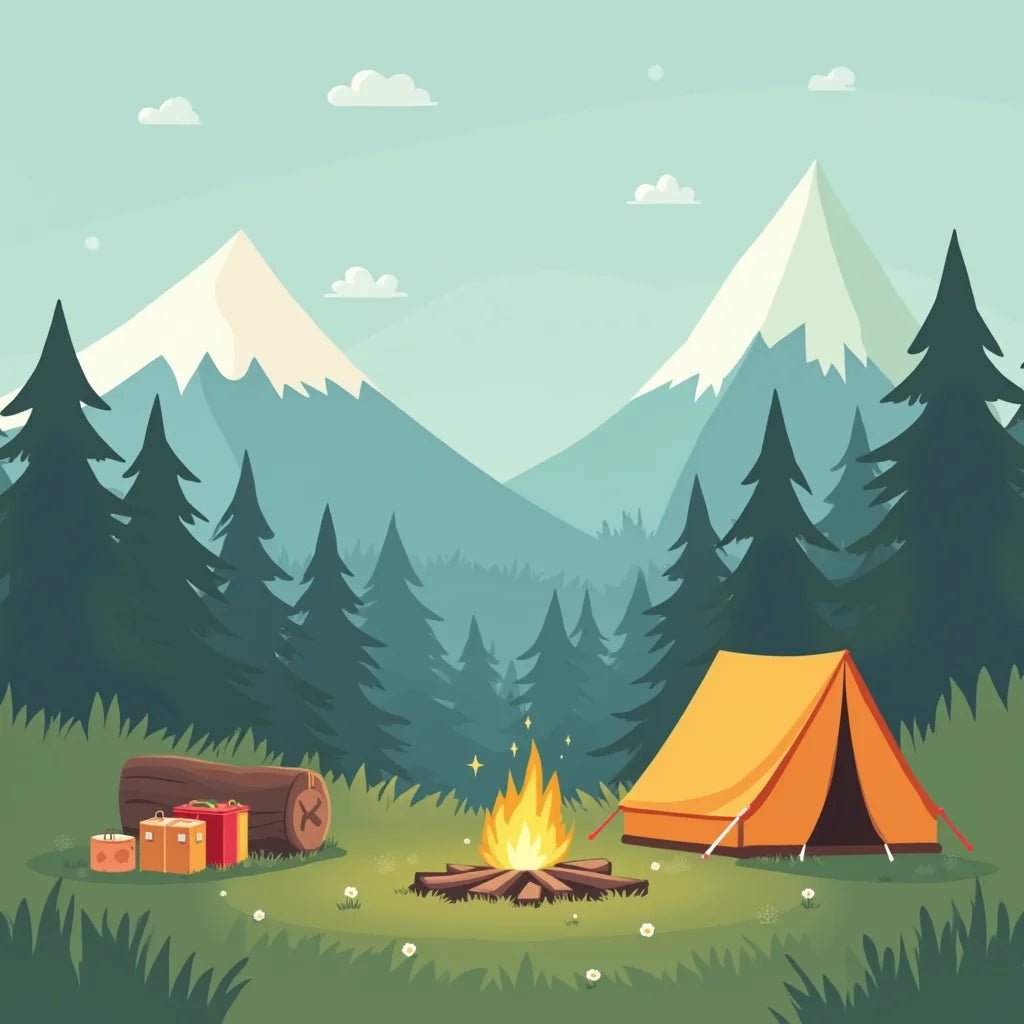Updated on: 2025-09-30
Table of Contents
-
Camping how-to guide: plan, pack, and set up
- Step 1: Choose your camping style and campgrounds
- Step 2: Build a simple packing list
- Step 3: Select a tent and sleeping system
- Step 4: Practice your tenting setup
- Step 5: Plan food and a safe camp kitchen
- Step 6: Stay warm, dry, and comfortable
- Step 7: Set up camp with care
- Step 8: Leave no trace and depart smoothly
- Family camping trip tips for low-stress fun
- Beginner-friendly camping gear checklist
- Common camping questions answered
Camping invites a slower pace, fresh air, and simple routines. If you are new to camping out or tenting, a thoughtful plan can ease nerves and make the first night feel comfortable. With a supportive campground choice, a manageable hiking plan, and a small list of reliable gear, it becomes easier to relax and enjoy the time outside. The ideas below focus on clarity and kindness, so you can prepare at your own speed and feel ready for your next trip.
Camping how-to guide: plan, pack, and set up
Step 1: Choose your camping style and campgrounds
It may help to start with drive-in campgrounds that offer amenities such as potable water, restrooms, and clear site pads. This keeps the first camping trip simpler and more predictable. If you enjoy hiking, selecting a campground with short, well-marked trails can be a gentle introduction before you consider longer hikes or backpacking. Some campers also appreciate a riverside site for calm scenery and fishing access; if that appeals to you, browsing the Clinch River area may offer helpful regional ideas.
- Check site photos and maps to understand tent pad size and layout.
- Read campground rules for quiet hours, fires, and pet policies.
- Consider proximity to trailheads if hiking is part of your plan.
Step 2: Build a simple packing list
A short list reduces stress. Prioritize shelter, sleep, clothing, food, water, and lighting. Add small comforts that make camping out feel cozy, like a familiar mug or a lightweight pillow. If you are unsure where to begin, you can keep it basic and expand over time.
- Shelter: tent, groundsheet, stakes, mallet, repair tape
- Sleep: sleeping bag, sleeping pad, pillow or stuff-sack pillow
- Clothing: layers for warmth, extra socks, rain jacket
- Kitchen: stove, fuel, lighter, pot, utensils, sponge, biodegradable soap
- Lighting: headlamp with extra batteries
- Navigation and safety: map, whistle, small first-aid kit
Step 3: Select a tent and sleeping system
For tenting, a two-wall tent (inner mesh plus rainfly) balances airflow and weather protection for many regions. A rectangular sleeping bag can feel roomy, and a well-insulated sleeping pad supports comfort and warmth. When choosing the best camping gear for beginners, aim for durable, simple designs that are easy to set up and maintain.
- Tent size: a “two-person” tent fits two tightly; consider sizing up for more space.
- Three-season rating: suitable for most mild weather camping.
- Sleeping pad R-value: higher values offer more insulation from cool ground.
Step 4: Practice your tenting setup
Before you arrive at campgrounds, a quick home practice can ease the first night. Set up the tent, attach the rainfly, stake corners, and practice rolling everything back into the bag. This small rehearsal can save time and help you adjust if anything feels confusing.
- Lay down a groundsheet slightly smaller than the tent floor.
- Stake the four corners first to hold shape, then add guy lines for stability.
- Note any missing stakes, bent poles, or trouble spots to fix in advance.
Step 5: Plan food and a safe camp kitchen
Simple meals often work best outdoors. Consider meals that are easy to cook in one pot and allow for straightforward cleanup. If your campground provides picnic tables and bear-resistant storage, that can simplify organization. When in river areas, local expertise from a guide service may offer helpful food storage or site tips specific to that environment.
- Pre-measure ingredients and label bags for clarity.
- Pack a small cutting board and a dedicated trash bag.
- Keep dish water away from streams and use appropriate waste disposal.
Step 6: Stay warm, dry, and comfortable
Layers are a gentle way to adapt to changing temperatures. Light, mid, and insulating layers allow you to adjust as needed. To keep dry, set the tent under the rainfly with taut lines so water sheds efficiently, and store clothing in a dry bag or inside the tent.
- Warmth at night: a beanie, dry socks, and a warm layer can add comfort.
- Ventilation: open tent vents to reduce condensation while maintaining weather protection.
- Camp chair: a compact chair supports relaxation and keeps you off damp ground.
Step 7: Set up camp with care
Arriving with enough daylight often feels calmer. Choose a flat spot for the tent, clear small twigs or stones, and observe how water might flow if it rains. Keep cooking and sleeping areas separate, and store food in appropriate containers as required by the campground.
- Respect quiet hours and neighboring sites.
- Use existing tent pads and fire rings whenever possible.
- Keep lights low to preserve night sky views and consider others nearby.
Step 8: Leave no trace and depart smoothly
Packing up with care helps future campers enjoy the spot as you did. Double-check for small items, scatter cooled ashes if permitted, and ensure the site looks as natural as you found it.
- Pack out all trash, food scraps, and micro-litter.
- Brush off gear and dry it at home to prevent mildew.
- Note what worked well and any items you wished you had.
Family camping trip tips for low-stress fun
Family camping can feel peaceful when plans are simple and flexible. Short drives, generous time for breaks, and familiar snacks can make the experience more enjoyable for everyone. Consider choosing campgrounds with nearby restrooms and easy walking paths. A short, scenic loop for hiking can offer movement without overtiring younger campers. If your plans include river views or shoreline time, browsing the Blog from local experts may inspire safe, family-friendly ideas for waterside exploration.
- Create a shared checklist and let each person pack one comfort item.
- Plan unstructured time for play and quiet reading.
- Choose early dinners and relaxed bedtimes to support rest.
- Assign gentle roles: one person handles the tent; another sets up the kitchen.
- Keep a small “fun kit” with cards, a nature guide, and a lightweight ball.
Beginner-friendly camping gear checklist
If you are wondering “What essential gear do I need for camping?” this shortlist covers the basics. It aims to balance affordability, durability, and ease of use, especially for the best camping gear for beginners.
- Tent and groundsheet: three-season tent with a full rainfly and sturdy stakes.
- Sleeping bag: an option that matches expected nighttime lows, plus a liner if desired.
- Sleeping pad: an inflatable or foam pad with enough insulation for the ground.
- Headlamp: one per person, with spare batteries.
- Stove and fuel: a stable, single-burner stove with wind shielding.
- Cook pot, mug, utensils: simple, nesting pieces to save space.
- Water containers: jugs for camp and bottles for hiking.
- Clothing layers: moisture-wicking base layers, insulating midlayer, weather shell.
- Footwear: well-broken-in hiking shoes or boots; sandals for camp comfort.
- Small first-aid kit: bandages, tape, antiseptic wipes, and any personal items.
- Navigation: paper map and compass, even if you plan to use a phone.
- Repair items: duct tape, multi-tool, extra cord, and patch kit.
For river-adjacent trips, it can be reassuring to chat with a local operator about site conditions or trail access. If that would be helpful, the Contact page can be a friendly place to start a conversation about regional considerations.
Common camping questions answered
What essential gear do I need for camping?
Most beginners do well with a tent, sleeping bag, sleeping pad, headlamp, simple stove, pot, utensil set, water containers, clothing layers, and a small first-aid kit. This covers shelter, sleep, food, water, and light—the core needs for camping out. As you gain experience, you may add a camp chair, a lantern, or extra comfort layers. Keeping the list short at first often feels manageable.
How do I stay warm while camping in cold weather?
Insulation from the ground is just as important as the sleeping bag, so consider a sleeping pad with sufficient R-value. Wearing dry socks and a warm hat at night can add comfort. Venting the tent slightly helps manage condensation, which keeps your sleep system drier. A warm beverage before bed may also feel soothing. If conditions look severe, choosing a different date or a campground with more shelter can be a considerate option.
How does hiking fit into a beginner camping itinerary?
Short, well-marked trails are a gentle way to include hiking without overexertion. Many campgrounds list trail lengths and difficulty, which helps with planning. Begin with brief outings and add distance as you feel comfortable. Carry water, a snack, and a small map for even the shortest loops.
How do I choose a campground for my first trip?
A site with restrooms, potable water, and clear tent pads can reduce uncertainty. Look for level ground, some shade, and access to short trails or picnic areas. If a calm river setting appeals to you, browsing regional pages like the Clinch River can offer helpful context about nearby recreation and site layouts.

Owner and CEO of Clinch River FIshing USA. A marine electroncs, fishing and outdoor store.

